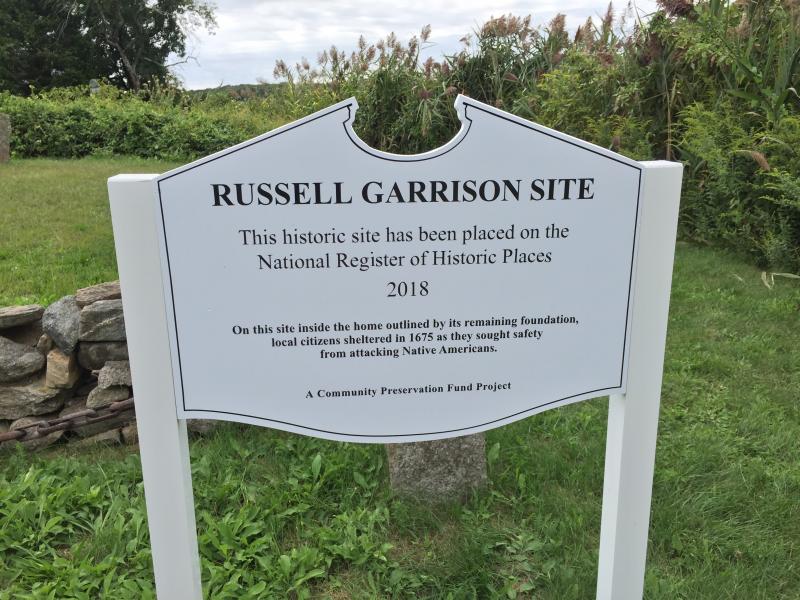Controversial Russell Garrison sign debated at public hearing
A controversial sign at one of Dartmouth’s historical sites had residents in a dither at Town Hall on Monday night, as the Historical Commission held a hearing for members of the public to air their views.
The Commission ultimately decided to set up an advisory group to work on the issue after around a dozen residents debated history for more than an hour in a discussion about contentious language on a new sign describing the 17th century Russell Garrison.
The sign announces the site’s inclusion on the National Register of Historic Places and briefly describes what occurred there in Dartmouth’s early days.
The garrison site is located on Fort Street in Padanaram. Built by John Russell, it was used as a refuge for settlers during a historic conflict — called King Philip’s War by colonists — in 1675.
Although the structure itself is gone, the stone foundation can still be seen from the street.
“On this site inside the home outlined by its remaining foundation, local citizens sheltered in 1675 as they sought safety from attacking Native Americans,” the sign reads.
According to archaeologist Holly Herbster — who has extensively researched historical accounts of the garrison — in July 1675, a group of Native Americans surrendered their weapons and sought refuge at the site.
Russell agreed, and offered them a nearby spit of land called Little Island as a refuge. However, they were later taken to Plymouth, where they were sold into slavery.
“There’s no indication the home the Russell family lived in was altered to use as a defensive spot during King Philip’s War, but it was during this period and in colonial records that Russell’s home began to be referred to as ‘The Garrison,’” Herbster said in a lecture last November. “That’s where the name comes from.”
Everyone at the hearing agreed that the language on the sign is too simplistic for describing a conflict that was extremely complex.
Residents took issue with the way the information is framed, saying it appears to be from the point of view of the colonists — particularly taking exception to the words “attacking” and “local citizens.”
UMass Dartmouth historian Jim Hijiya spoke first. “I was disturbed when I saw that sign, because it seemed to me to be one-sided, that it presented history from the point of view of the English colonists here in Dartmouth,” he said.
Hijiya noted that referring to the English settlers as ‘local citizens’ makes them more sympathetic, because “as a person going to the site, most of us feel that we are local citizens, so that represents us.”
“The way that [the sign] is phrased, it portrays the English as the good guys, basically, who were just sitting there on their farm and for no discernible reason these savages attacked them, so they had to defend themselves...and that is the implicit message,” he said. “I thought we should make much more of an attempt to present the whole picture, present it from the Native point of view. Why did they attack? It’s not because that’s just what Indians do.”
At the meeting Hijiya provided a possible alternative text that presented the larger context of the incident, and avoided the problematic terms.
Part of this suggested text reads “Angered by the loss of land, liberty, and lives, Native Americans all across southern New England took up arms. Some of the English colonists took refuge in a house that stood at this location, and, after a two-day siege, the Natives withdrew.”
Many at the meeting agreed with Hijiya, and some argued for even more context.
Dartmouth resident and historian Sally Aldrich said, “My personal objection to the sign is the word ‘attacking,’ because I know that that is not true.”
“It is important in telling stories that names are appropriate,” said Erik Andrade, who noted that erasure of tribal names — referring to diverse groups of people as simply “Indians” or “Natives” — stems from a Eurocentric viewpoint of history.
“King Philip’s War was quite complicated,” noted retired UMass Dartmouth historian Gerard Koot. “There were actually Native Americans fighting alongside colonists as well as opposing the colonists.”
“The natives were the victims in this,” he added.
Ideas to change the sign brought up at the hearing included simply painting out the offending phrases and replacing them with something new, replacing the entire sign, or adding a link or QR code to a website with more information and context.
Another idea was to create signs for Native American sites of significance around the town.
One positive aspect of the controversy, noted Commission member Diane Gilbert, was that it has elicited a lot of interest in Dartmouth’s history.
The Commission agreed that the sign needs to be changed, but as a decision could not be reached as to exact wording, it ultimately voted to set up an advisory group to work on the language for a new sign.
“I think it’s a very good way to go at it,” said Commission Chair Judith Lund of the strategy. “It brings more people into it than we had initially.”
This article has been edited to include more context and quotes from participants at the hearing.












